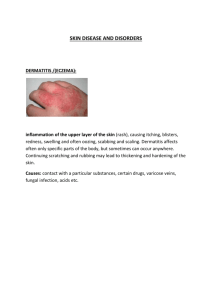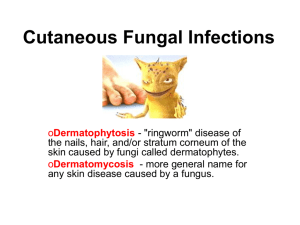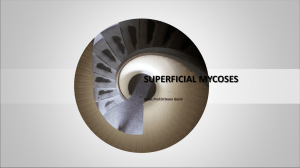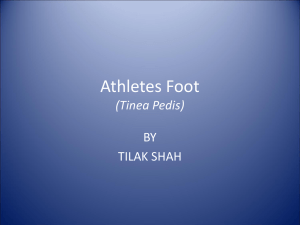Cutaneous mycoses
advertisement
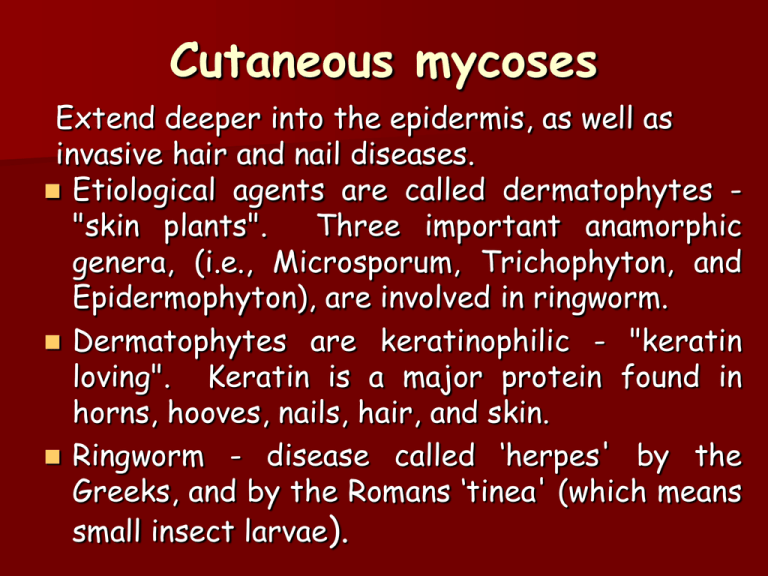
Cutaneous mycoses Extend deeper into the epidermis, as well as invasive hair and nail diseases. Etiological agents are called dermatophytes "skin plants". Three important anamorphic genera, (i.e., Microsporum, Trichophyton, and Epidermophyton), are involved in ringworm. Dermatophytes are keratinophilic - "keratin loving". Keratin is a major protein found in horns, hooves, nails, hair, and skin. Ringworm - disease called ‘herpes' by the Greeks, and by the Romans ‘tinea' (which means small insect larvae). Infections by Dermatophytes Severity of ringworm disease depends on (1) strains or species of fungus involved and (2) sensitivity of the host to a particular pathogenic fungus. More severe reactions occur when a dermatophyte crosses non-host lines (e.g., from an animal species to man). Among dermatophytes there appears to be a evolutionary transition from a saprophytic to a parasitic lifestyle. – Geophilic species - keratin-utilizing soil saprophytes (e.g., M. gypseum, T. ajelloi). Transmitted to humans by direct exposure. – Zoophilic species - keratin-utilizing on hosts - living animals (e.g., M. canis, T. verrucosum). Direct transmission to humans by close contact with animals. – Anthropophilic species - keratin-utilizing on hosts - humans (e.g., M. audounii, T. tonsurans). Person -to-person transmission through contaminated objects (comb, hat, etc.) Clinical manifestations of ringworm infections are called different names on basis of location of infection sites tinea capitis - ringworm infection of the head, scalp, eyebrows, eyelashes tinea favosa - ringworm infection of the scalp (crusty hair) tinea corporis - ringworm infection of the body (smooth skin) tinea cruris - ringworm infection of the groin (jock itch) tinea unguium - ringworm infection of the nails tinea barbae - ringworm infection of the beard tinea manuum - ringworm infection of the hand tinea pedis - ringworm infection of the foot (athlete's foot) Species found in different anamorphic genera are the cause of different clinical manifestations of ring worm Microsporum - infections on skin and hair (not the cause of TINEA UNGUIUM) Epidermophyton - infections on skin and nails (not the cause of TINEA CAPITIS) Trichophyton - infections on skin, hair, and nails. Major sources of ringworm infection Schools, military camps, prisons. Warm damp areas (e.g., tropics, moisture accumulation in clothing and shoes). Historical note: More people were shipped out of the Pacific Theater in WWII back to U.S. because of ringworm infection then through injury. Animals (e.g., dogs, cats, cattle, poultry, etc.). Diagnosis Note the symptoms. Microscopic examination of slides of skin scrapings, nail scrapings, and hair. Often tissue suspended in 10 % KOH solution to help clear tissue. Slides prepared this way are not permanent. These degrade rapidly due to presence of base. Isolation of the fungus from infected tissue. Proper treatment is dependent on diagnosis and prognosis. Tinea corporis – body ringworm Tinea Cruris – Jock Itch tinea favosa Tinea Unguium – Nail Infection Tinea Capitis Gray Patch - Tinea barbae - ringworm of the bearded areas of the face and neck. Tinea Pedis – Athlete’s Foot Infection Dermatophytes 3 Genera Trichophyton Microsporum Epidermophyton Trichophyton (19 species) Hair Skin Nails Trichophyton rubrum Infects nails and smooth skin (rarely found on hair). Most common and widely distributed dermatophyte on man and rarely isolated from animals, never from soils. No teleomorph (possibly lost in transition from saprophytic lifestyle to man). Resistant and persistent (some people become carriers for life). Slow-growing in culture. When intensely pigmented in culture the color is reminiscent of port burgundy wine or venous blood. Production of pigment increased, if fungus grown on corn meal agar. Microconidium are clavate or "teardrop" shape with a broad attachment point of the hyphae. Microconidia may develop on sides of macroconidium. In vitro - lack of hair penetrating organs, unlike T. mentagrophytes. T. violaceum grows poorly without thiamine. T. megninii grows poorly without L-histidine. T. rubrum requires neither thiamine or L- histidine. Trichophyton rubrum http://www.mycology.adelaide.edu.au/Fungal_Descriptions/Dermatophytes/Trichophyton/rubrum.htm Trichophyton mentagrophytes http://www.mycology.adelaide.edu.au/Fungal_Descriptions/Dermatophytes/Trichophyton/mentagrophytes.html Microsporum (13 species) Skin Hair Microsporum gypseum Teleomorphs are Arthroderma gypseum and A. incurvatum. Produces abundant macroconidia brownish-yellow due to large numbers macroconidia. Surface of culture colony often is powdery in appearance. Reverse of colony often appears ragged around edges. Macroconidia usually have 4-6 septa or crosswalls. Microconidia are smaller than in M. canis. Macroconidia up to 40 µm long In lactophenol, water is extracted and can cause the macroconidia walls to collapse. This is an artifact due to mounting media. Macroconidia do not form on infected hair! Microsporum gypseum http://www.doctorfungus.org/thefungi/microsporum_gypseum.htm http://www.mycology.adelaide.edu.au/Fungal_Descriptions/Dermatophytes/Microsporum/Microsporum_gypseum.htm Microsporum canis Teleomorph is an ascomycete called Arthroderma otae. Almost all clinical isolates are minus mating type. Macroconidia are abundant, thick-walled with many septa, up to 15. Macroconidia are often hooked or curved at ends. Microconidia are small and clavate (clubshaped). Microsporum canis Teleomorph: Arthroderma otae http://www.doctorfungus.org/thefungi/microsporum_canis.htm http://www.mycology.adelaide.edu.au/Fungal_Descriptions/Dermatophytes/Microsporum/Microsporum_canis.html Epidermophyton floccosum Skin Nails Epidermophyton floccosum Only one pathogenic species in this genus. Tinea unguium and tinea cruris are often caused by this fungus. Culture starts out white/turns sulfur color. Cultures may be wrinkled to cottony in appearance. No microconidia. Shape of macroconidia is a distinguishing characteristic - clavate macroconidia. Epidermophyton floccosum Bifurcated hyphae with multiple, smooth, club shaped macroconidia (2-4 cells) Epidermophyton floccosum http://www.doctorfungus.org/thefungi/epidermophyton.htm http://www.mycology.adelaide.edu.au/Fungal_Descriptions/Dermatophytes/Epidermophyton/ General characteristics of Macroconidia and Microconidia of Dermatophytes Genus Macroconidia Microconidia Microsporum Numerous, thick walled, rough Rare Epidermophyton Numerous, smooth walled Rare,thin walled, smooth Absent Trichophyton Abundant DERMATOPHYTOSIS Treatment Topical Miconazole, clotrimazole, econazole, terbinafine... Oral Griseofulvin Ketaconazole Itraconazole Terbinafine
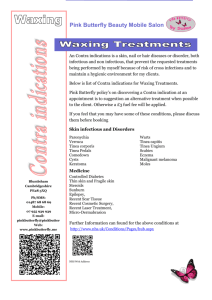
![Occupational Health - Zoonotic Disease Fact Sheets #15 DERMATOMYCOSES Foot)]](http://s2.studylib.net/store/data/013216770_1-db2cdf56a16f26d122fecafe6758caad-300x300.png)
